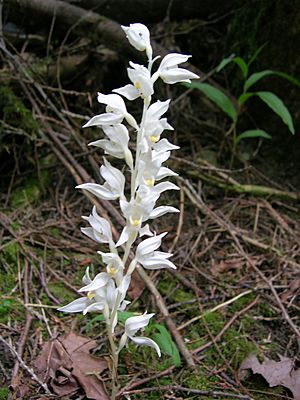Cephalanthera austiniae facts for kids
Quick facts for kids Cephalanthera austiniae |
|
|---|---|
 |
|
| Scientific classification | |
| Genus: |
Cephalanthera
|
| Species: |
austiniae
|
| Synonyms | |
|
|
The phantom orchid (scientific name: Cephalanthera austiniae) is a very special type of orchid. It's called "phantom" or "snow orchid" because it's almost completely white! It only has a few yellow spots on its flowers.
You can find this orchid in the western United States (like California, Oregon, Washington, and Idaho) and in British Columbia, Canada. It's the only type of Cephalanthera orchid that grows in the Western Hemisphere.
Unlike most plants, the phantom orchid doesn't make its own food using sunlight. It has no chlorophyll, which is the green stuff in plants that helps them do that. Instead, it gets all its food from tiny fungi in the soil. This way of living is called mycoheterotrophy.
What Does the Phantom Orchid Look Like?
The phantom orchid is easy to spot in the forest. It grows up from the dark, wet ground. Its stems are waxy and white.
The flowers are also white or yellowish. They have bright yellow centers. The plant doesn't have regular leaves. It doesn't need them because it doesn't collect sunlight.
Instead, this orchid gets all its energy and food from special fungi. These fungi live around the orchid's roots. They help the orchid get what it needs to grow.
Why is the Phantom Orchid Rare?
The phantom orchid is becoming harder to find. This is because its home, which is dense and quiet forests, is slowly disappearing.
Scientists are also worried about climate change. They predict that this orchid might disappear by the year 2100. This makes it very important to protect the forests where it lives.
See also
 In Spanish: Cephalanthera austiniae para niños
In Spanish: Cephalanthera austiniae para niños

